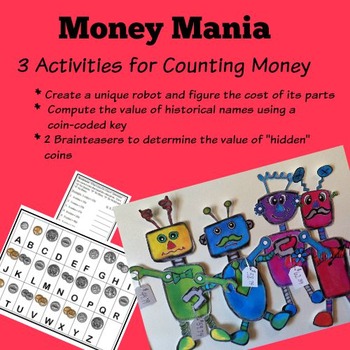Money 3rd Grade
Dazzle on a Dime
1k Followers
Grade Levels
3rd - 4th, Homeschool
Subjects
Resource Type
Standards
CCSS4.MD.A.2
CCSS3.NBT.A.2
Formats Included
- Zip
Pages
36 pages
Dazzle on a Dime
1k Followers
Description
Money 3rd Grade: Counting Money 3rd Grade - Determine the value of a collection of coins and bills.
| 3.NBT.A.2 | 4.MD.A.2 | TEKS 3.4C | 3.4C | Add | Subtract | Add Money | Subtract Money | Add and Subtract Decimals | 3rd grade | 4th Grade |
This product includes the following resources to support the skill of counting money:
*28 pages of Money Mania activities and instructions
~ Create a robot and add or subtract all the parts to determine its value
~ Determine the value of historical names using a coin-coded key
~ 2 Brainteasers using logical thinking to determine the value of “hidden” coins
* 8 pages of clip art money to sort, count and add or subtract.
See the preview for more details.
This product also comes bundled with a PowerPoint for TEKS standard 3.4C
The bundled product which includes the PowerPoint and the three activities that support 3.4C
Please visit My TpT Store for more engaging resources.
You may also like
3.4A Addition and Subtraction PowerPoint
Place Value Bundle
Brain Breaks
Anchor Activities for Early Finishers
This product, created by Paula McClendon, at Dazzle on a Dime, LLC is licensed for one classroom use only. If you wish to share this resource, additional licenses can be purchased at a discounted price.
| 3.NBT.A.2 | 4.MD.A.2 | TEKS 3.4C | 3.4C | Add | Subtract | Add Money | Subtract Money | Add and Subtract Decimals | 3rd grade | 4th Grade |
This product includes the following resources to support the skill of counting money:
*28 pages of Money Mania activities and instructions
~ Create a robot and add or subtract all the parts to determine its value
~ Determine the value of historical names using a coin-coded key
~ 2 Brainteasers using logical thinking to determine the value of “hidden” coins
* 8 pages of clip art money to sort, count and add or subtract.
See the preview for more details.
This product also comes bundled with a PowerPoint for TEKS standard 3.4C
The bundled product which includes the PowerPoint and the three activities that support 3.4C
Please visit My TpT Store for more engaging resources.
You may also like
3.4A Addition and Subtraction PowerPoint
Place Value Bundle
Brain Breaks
Anchor Activities for Early Finishers
This product, created by Paula McClendon, at Dazzle on a Dime, LLC is licensed for one classroom use only. If you wish to share this resource, additional licenses can be purchased at a discounted price.
Total Pages
36 pages
Answer Key
Included
Teaching Duration
N/A
Last updated Sep 2nd, 2015
Report this resource to TPT
Reported resources will be reviewed by our team. Report this resource to let us know if this resource violates TPT’s content guidelines.
Standards
to see state-specific standards (only available in the US).
CCSS4.MD.A.2
Use the four operations to solve word problems involving distances, intervals of time, liquid volumes, masses of objects, and money, including problems involving simple fractions or decimals, and problems that require expressing measurements given in a larger unit in terms of a smaller unit. Represent measurement quantities using diagrams such as number line diagrams that feature a measurement scale.
CCSS3.NBT.A.2
Fluently add and subtract within 1000 using strategies and algorithms based on place value, properties of operations, and/or the relationship between addition and subtraction.





